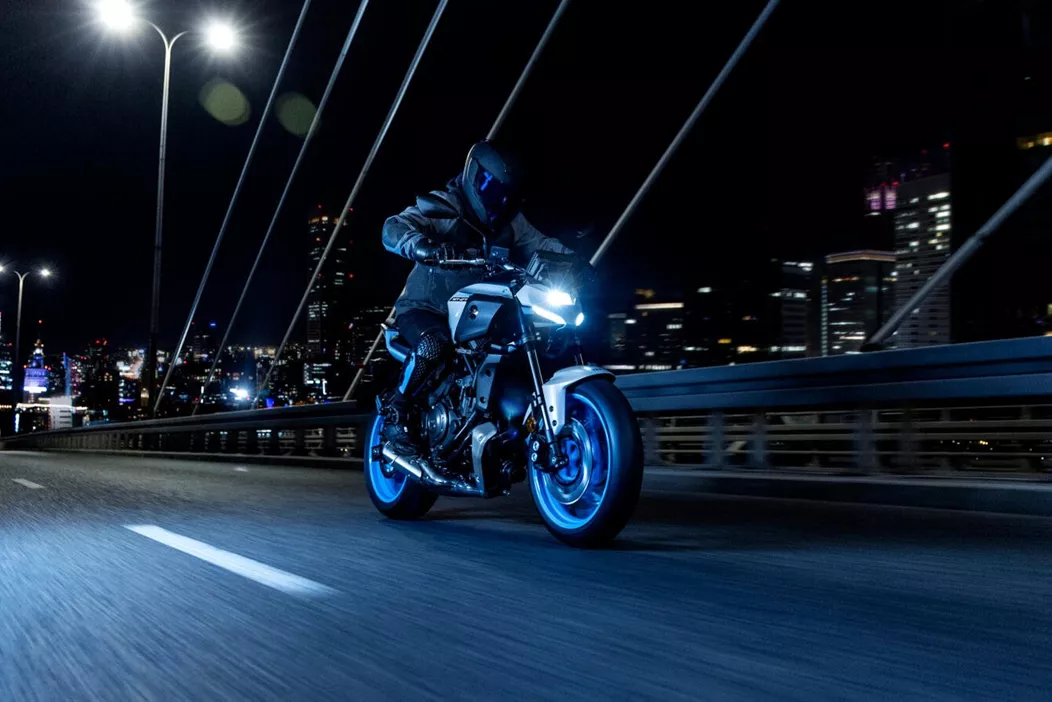Mein Kollege Horvath hat alle Neuheiten und Updates für die Yamaha MT-07 2025 bereits hier zusammengefasst. Wir haben auch ein Video dazu. Daher soll es in diesem Testbericht darum gehen, wie sich all diese Änderungen tatsächlich im Alltag fahren. Die vierte Generation wurde so grundlegend überarbeitet, dass wir die Highlights kurz zusammenfassen wollen: Neues Design, umfangreiches Elektronik-Update, zwei verschiedene Getriebevarianten, komplett neues Fahrwerk, Radialbremszangen vorne, neue Ergonomie und Euro5+-Anpassungen für den bekannten CP2-Motor.
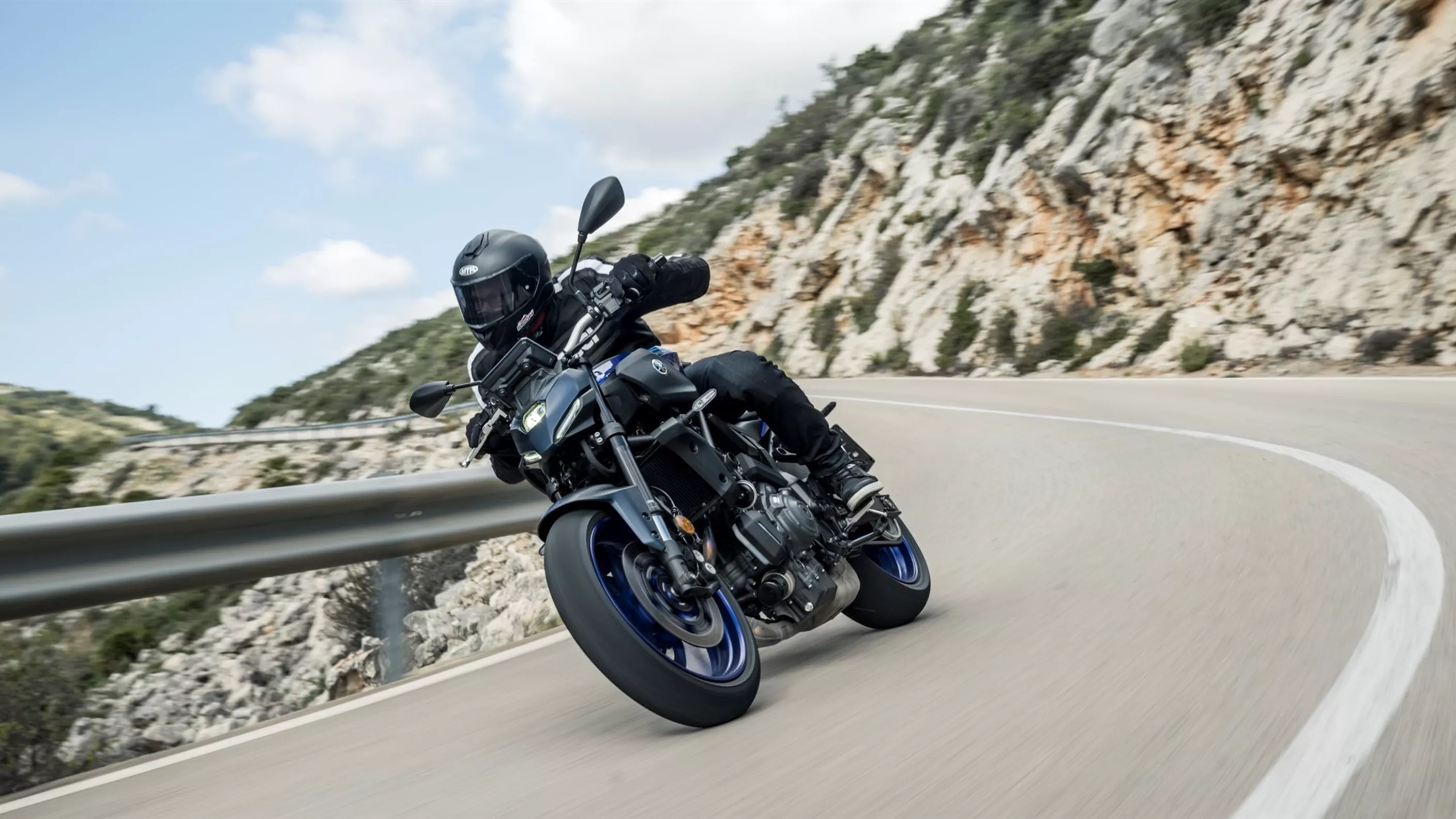
Test Yamaha MT-07 2025
Die beste MT-07 die wir je hatten.
Die MT-07 ist für Yamaha extrem wichtig. Seit ihrer Einführung im Jahr 2014 wurden alleine in Europa bis dato rund 195.000 Stück verkauft. Für das Jahr 2025 hat Yamaha der MT-04 ein großes Update gegönnt, denn die vierte Generation sollte reifer werden, um noch mehr Motorradfahrer anzusprechen. So viel sei schon jetzt verraten: Das ist geglückt. Die neue Yamaha MT-07 ist definitiv die beste MT-07, die wir bis jetzt hatten. Aber: Es könnte für Yamaha und deren Händler auch zu einem Luxus-Problem werden.
&width=72&height=72&bgcolor=rgba_39_42_44_0&mode=crop)
Philipp
published on 3/30/2025
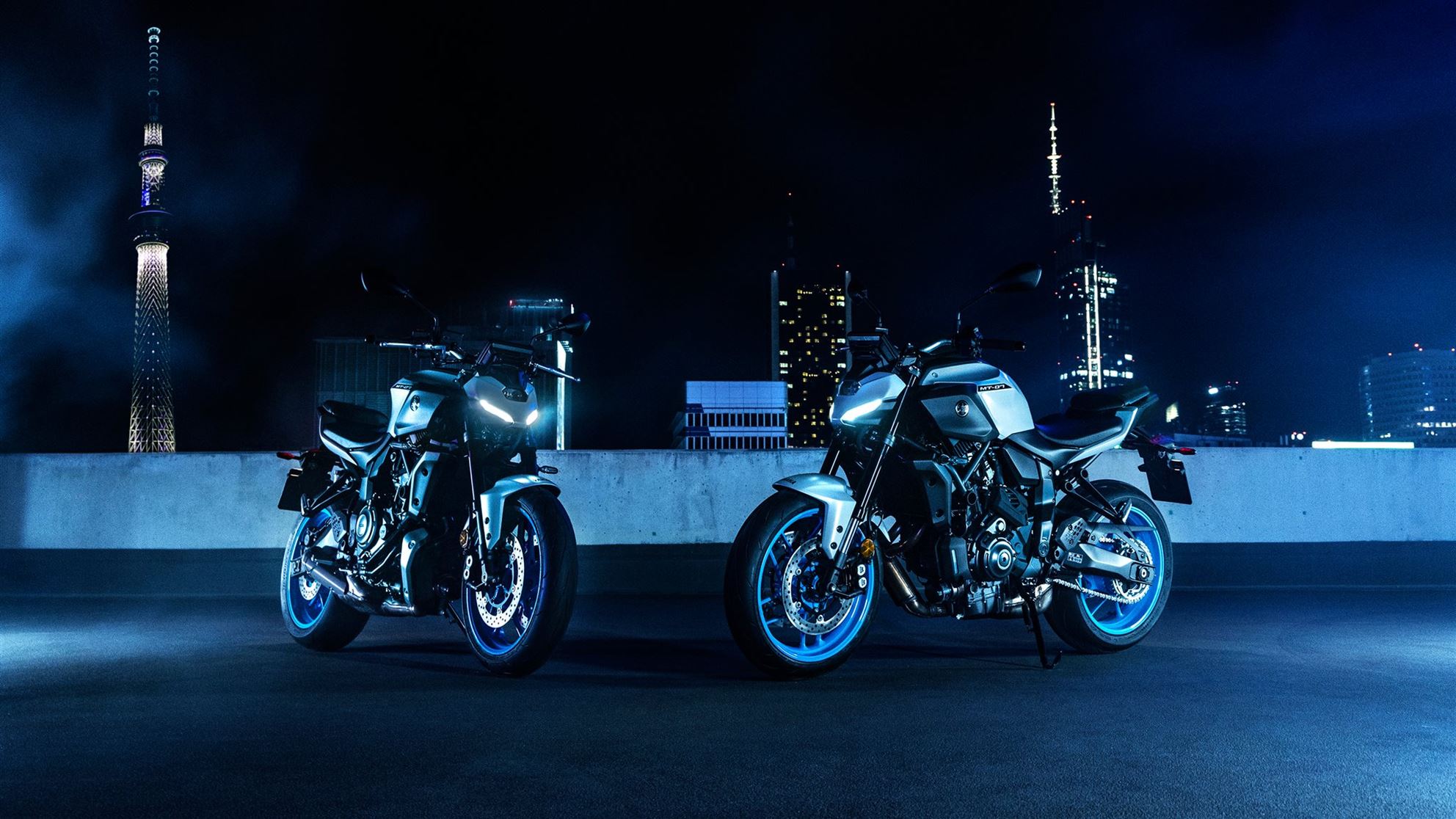
Die neue MT-07 ähnelt der MT-09 sehr.
Die Yamaha MT-07 ist reifer geworden
Die MT-07 war aus verschiedenen Gründen bisher ein Verkaufsschlager: Zum einen bot sie seit ihrer Einführung 2014 immer sehr viel Motorrad ums Geld. Das größte Kaufargument bis jetzt: Der Reihenzweizylinder-Motor (CP2 getauft von Yamaha), der drehmomentorientiert zu Werke geht, dabei immer schon fein abgestimmt war und sowohl Anfänger als auch Motorradveteranen auf der Landstraße ein Lächeln ins Gesicht zauberte. Der Sound war frech, die Gasannahme, die Drehfreude und Kraftentfaltung nahezu makellos. So geht Landstraßenmotor – Punkt.
Dazu spendierte Yamaha der MT-07 immer ein solides aber auch unspektakuläres Chassis. Das Motorrad war eher klein und kompakt, das Fahrwerk (vor allem die Gabel) etwas unterdämpft, was dazu führte, dass beim späten, harten Anbremsen die Gabel stark abgetaucht ist und das Motorrad förmlich in die Knie ging. Für Anfänger absolut ausreichend, doch ab höherem Fahrkönnen leider etwas zu lasch. Yamaha besserte nach, aber die Konkurrenz holte rasch auf und überholte die MT-07 in den letzten Jahren. Vor allem die Suzuki GSX-8S hat in dieser Klasse ein sehr harmonisches Fahrwerk zu bieten und bildet die Benchmark. Beim Motor ist es mittlerweile die Honda CB 750 Hornet in der Klasse. Außerdem fehlte der MT-07 zum Schluss ein modernes Elektronikpaket.
Doch die erfreuliche Nachricht: All das hat Yamaha beherzigt und in der vierten Generation reingepackt. Ohne dabei ihren Grundcharakter des zugänglichen Nakedbikes für praktisch jedermann zu verlieren.
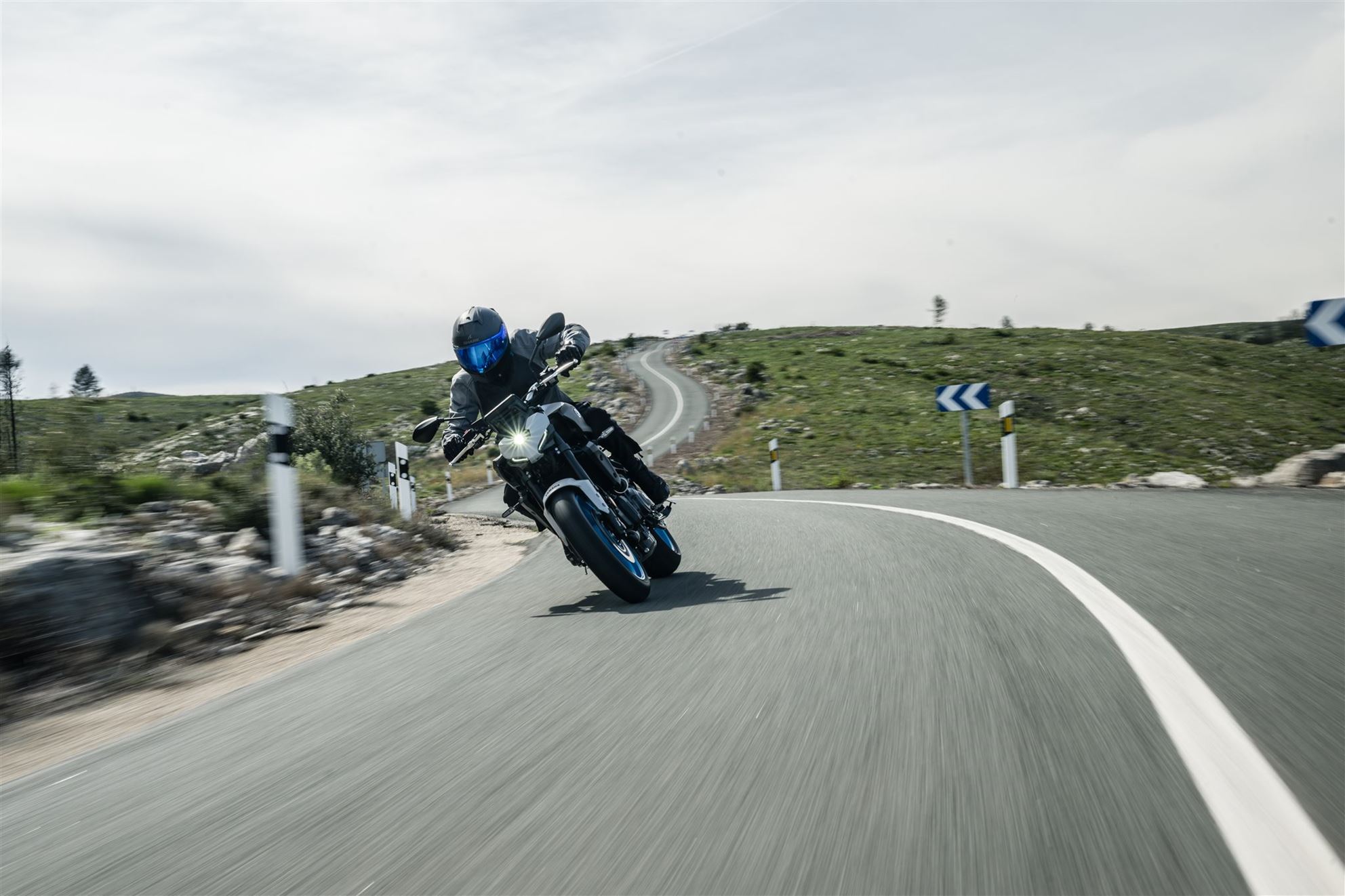
Besser als je zuvor - die neue MT-07.
Fahrwerk mit Update Yamaha MT-07 – feines Handling
Vorne kommt nun eine neue 41-mm-USD-Gabel von KYB (nicht einstellbar) zum Einsatz. Diese wird in eine neue, leichtere Aluminium-Gabelbrücke geklemmt (-400 Gramm) und sorgt für eine deutlich bessere Dämpfung samt Optik. Am unteren Ende der Gabel beißen nun zwei Radialbremszangen von Advics mit je vier Bremskolben in die unverändert 298 Millimeter großen Bremsscheiben. Das schaut nicht nur optisch moderner und sportlicher aus, es fährt sich auch so. Lobende Worte an der Stelle für die Bremse: Obwohl die Scheiben- und Bremsbelagskombination gleichgeblieben ist, ist das Bremsgefühl etwas präziser. Leider kommen immer noch nicht wartungsfreie Gummibremsschläuche zum Einsatz.
Dazu kommen noch leichte Spinforged-Felgen – ein Yamaha-Patent, womit Felgen bei gleicher Robustheit leichter gebaut werden können. Die Gabel bietet nun deutlich mehr Feedback und Reserven, taucht nicht mehr so stark beim Anbremsen ein und bietet in jeder Fahrsituation hydraulische Dämpferunterstützung. Dabei ist das Setting so gewählt, dass man selbst kurze, knackige Stöße gut kompensieren kann ohne Lenkerschlagen zu bekommen. Eine wirklich große Verbesserung zu allen drei Vorgängergenerationen. Da die Front der neuen Yamaha MT-07 nun so viel besser und auch sportlicher geworden ist, musst der Hauptrahmen angepasst werden, die Schwinge und auch die Hinterradaufhängung (das Federbein ist in Vorspannung und Zugstufe einstellbar).
Yamaha gibt an, dass das Chassis im gesamten um 13 Prozent steifer geworden ist. Das spürt man dem Motorrad auch auf jedem Meter an – gut so. Das Handling ist dabei unverändert geblieben: Das Motorrad lenkt präzise und leichtfüßig ein, bleibt jetzt aber länger stabil und berechenbar. Zusammen mit der tadellosen Bremse lässt sich jeder Kurveneingang - ob langsam oder zügig - punktgenau treffen. Das Plus an Stabilität durch das neue Fahrwerk lässt die MT-07 spürbar näher an die große Schwester MT-09 rücken.
Das liegt auch an der neuen, besseren weil etwas fahraktiveren Ergonomie: Der Lenker ist breiter geworden und sitzt nun 2,2 Zentimeter tiefer. Dadurch bekommt der Fahrer mehr Feedback vom Vorderrad. Die Fußrasten sind um einen Zentimeter tiefer platziert, streifen aber aufgrund des besseren Fahrwerks und etwas engeren Positionierung am Rahmen deutlich später als bei den Vorgängermodellen. Und das obwohl man nun einen entspannteren Kniewinkel hat – gerade für größere Fahrer über 1,75 Meter Körpergröße ein ganz klares Plus. Zusammen mit der neuen Bereifung (Dunlop Sportmax Q5A) erfreut man sich im Sattel der MT-07 am einfachen, berechenbaren Handling und wundert sich förmlich, warum das nicht schon immer so war. Eine schlicht großartige Verbesserung – ganz ohne Schattenseite.
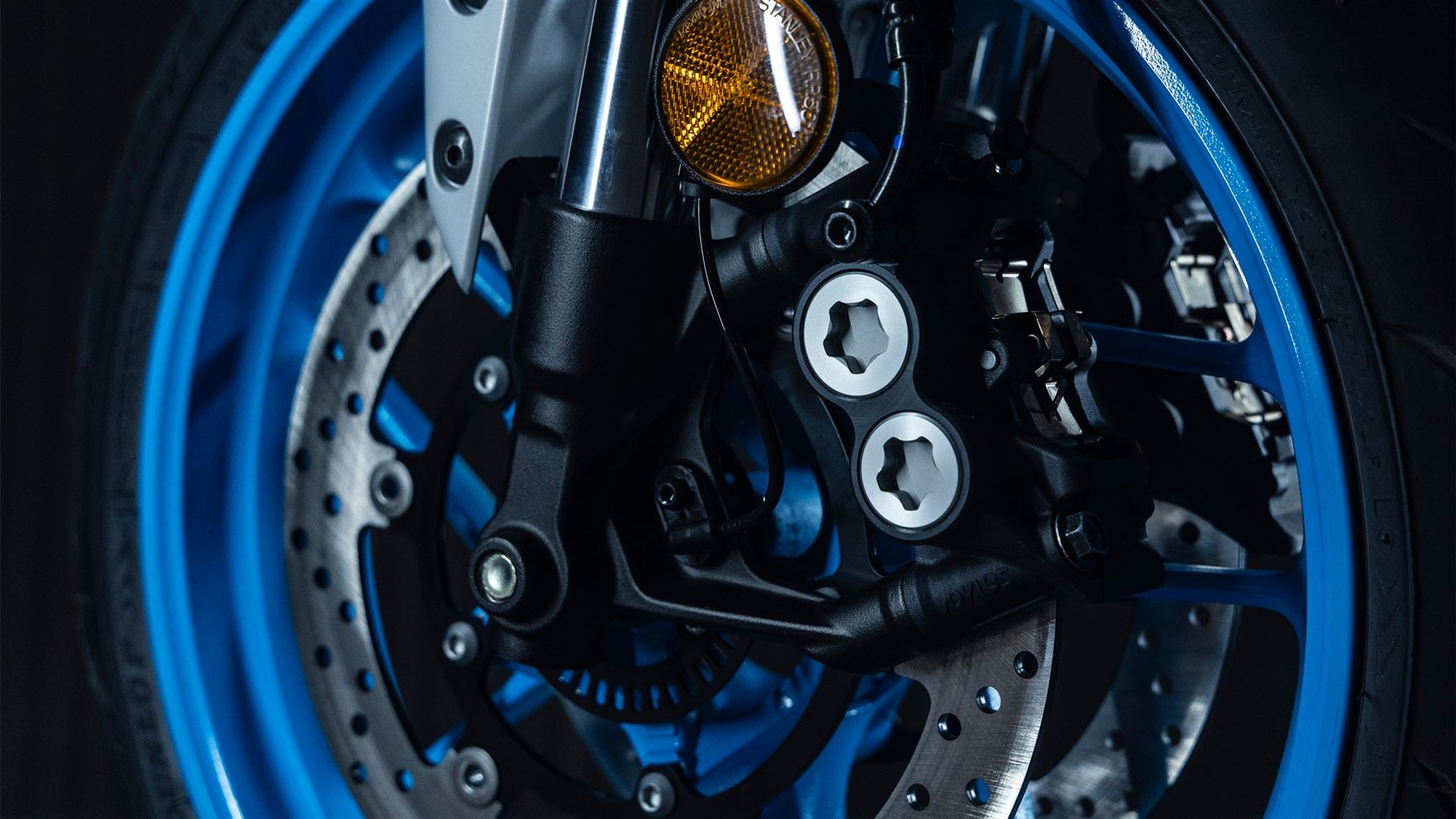
Neue Bremsanlage, neue Gabel, massive Verbesserung.
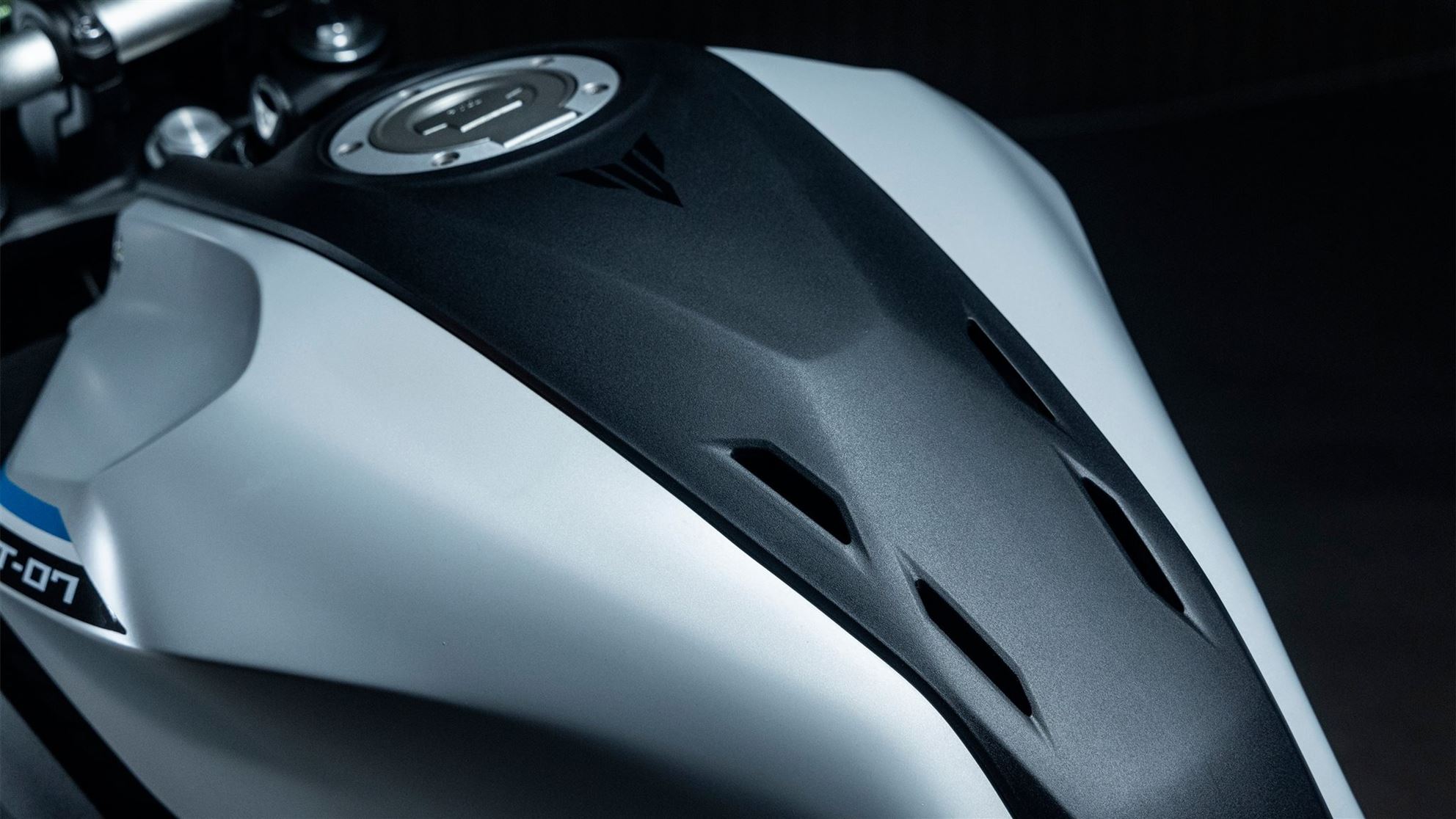
Die vier kleinen Schlitze in der Tankabdeckung sorgen für einen coolen Sound für den Fahrer.
Yamaha CP2-Motor – alles bleibt besser
Am Motor hat sich konstruktiv nicht viel getan: Aus 689 Kubikzentimetern Hubraum holt der Reihenzweizylinder noch immer 73,4 PS (54 kW) bei 8.750 Umdrehungen pro Minute und 68 Newtonmeter Drehmoment bei 6.500 rpm. Fein: Trotz Euro5+-Updates konnten die Yamaha-Ingenieure das Drehmoment in der Drehzahlmitte verbessern, man hat jetzt also mehr Schmalz früher anliegen. Auf der Testfahrt war das jedoch nicht wirklich spürbar, denn es gab bis dato am CP2-Motor der MT-07 nie viel Kritik, so auch in der Modellgeneration 2025 nicht.
Nettes Gimmick von Yamaha: Um den sportlichen Sound trotz strengerer Vorgaben zu erhalten, gibt es nun in der mittleren Tankabdeckung vier Schlitze. Darunter befindet sich der „Sound Enhancer“, der das Ansauggeräusch an den Fahrer weitergibt. Und das funktioniert im Fahrbetrieb sehr gut, denn im Sattel der MT-07 hat man stets einen potenten, bassigen Zweizylindersound im Ohr. Yamaha gibt den Verbrauch des Triebwerks mit 4,1 Liter auf 100 Kilometer an. Das schafft man nur, wenn man eher gemäßigt unterwegs ist. Lässt man den CP2-Motor und seiner Drehfreude freien Lauf, rinnt doch etwas mehr Benzin durch die Brennräume.
Das Tankvolumen von 13 Litern ist geblieben und rund 250 Kilometer Reichweite schafft man damit auch bei sehr sportlicher Fahrweise. Optional gibt es die neue Yamaha MT-07 auch als 48PS (35 kW) A2-Variante.
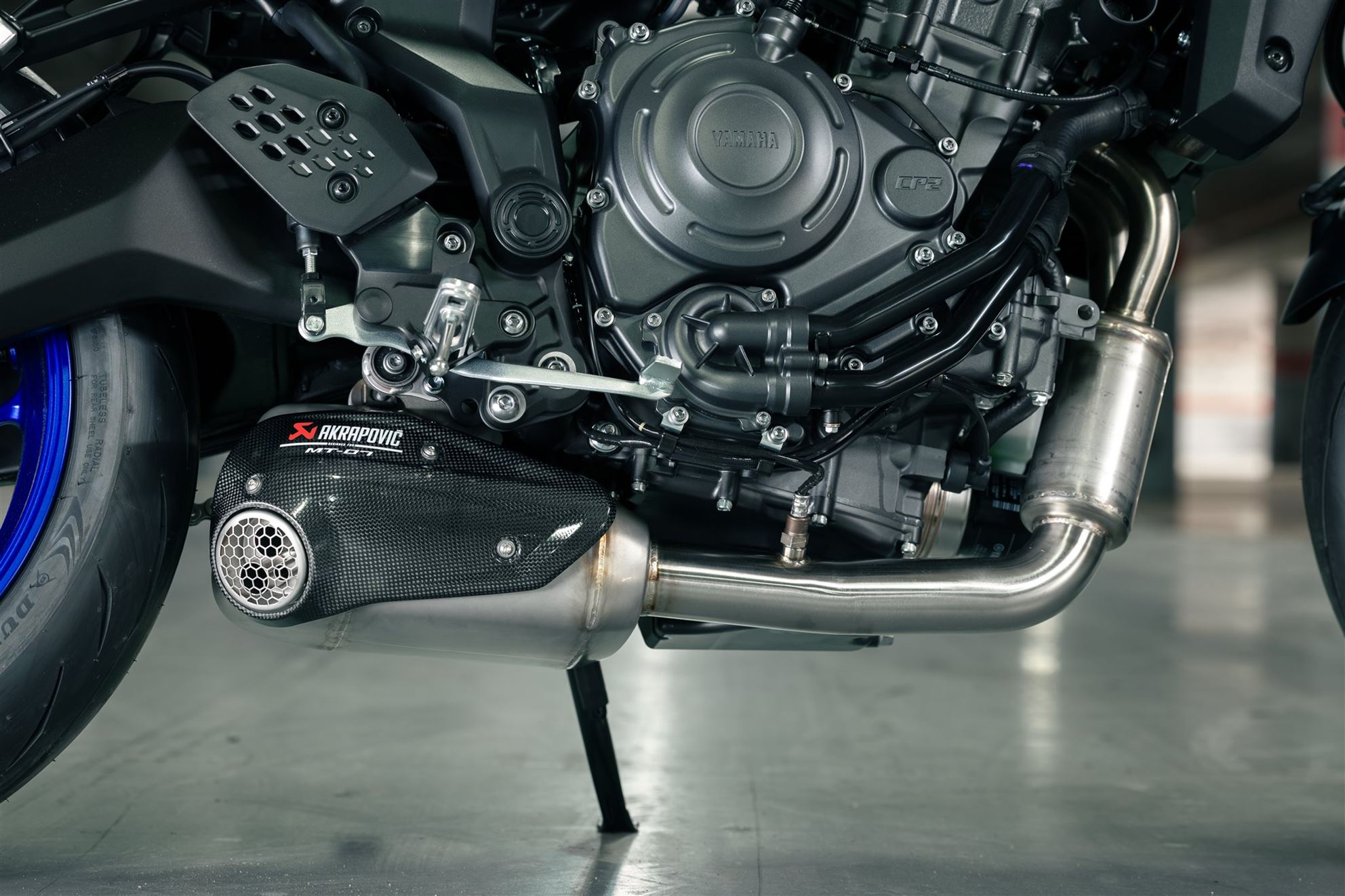
Optional erhältlich: der Akrapovic-Auspuff
Highlight der MT-07: Y-AMT – zwei Getriebearten
Technisch und fahrdynamisch ist das neue Yamaha-Getriebe Y-AMT (Yamaha Automated Manual Transmission) die größte Neuheit. Es ist ein halbautomatisches Schaltsystem, das auf einem konventionellen Schaltgetriebe basiert, aber die Kupplungs- und Schaltvorgänge automatisiert.
Im Kern steckt ein elektronisch gesteuerter Aktuator, der Kupplung und Schaltmechanismus präzise und schnell bedient – ganz ohne Kupplungshebel. Der Fahrer kann dabei zwischen verschiedenen Modi wählen: Automatikmodus (AT-Modus), hier übernimmt das System vollständig das Schalten, ähnlich wie bei einem klassischen Automatikgetriebe. Manueller Modus (MT-Modus): Der Fahrer schaltet selbst per Knopfdruck am Lenker hoch oder runter – ohne Kuppeln zu müssen. Das passiert über den von Yamaha genannten See-Saw-Schalter auf der linken Lenkerarmatur. Kupplungshebel und Schalthebel gibt es bei dem System nicht mehr.
Der AT-Modus hat zwei Untermodi: D und D+. Bei D+ ist die Schaltlogik etwas sportlicher ausgelegt. Das bedeutet: Die MT-07 schaltet später hoch, lässt einen die Gänge mehr ausdrehen und früher runter, um auch mit niedrigeren Gängen und hohen Drehzahlen fahren zu können, beispielsweise wenn man Kurven spät und sportlich anbremst. Y-AMT wiegt nur 2,8 Kilogramm und hebt das Gesamtgewicht fahrfertig von 183 auf 186 Kilogramm. Y-AMT kann sowohl als Komfort- als auch Performance-Feature verstanden werden.
Bei unserer Testfahrt im spanischen Hinterland von Alicante, wo man förmlich von einer engen Kurve in die nächste fällt, konnten wir das System sehr ausgiebig testen. Ebenfalls erhältlich: Ein konventionelles 6-Gang-Schaltgetriebe, optional mit Quickshifter für kupplungsloses Hoch- und Runterschalten. Den Quickshifter konnten wir leider nicht ausprobieren.
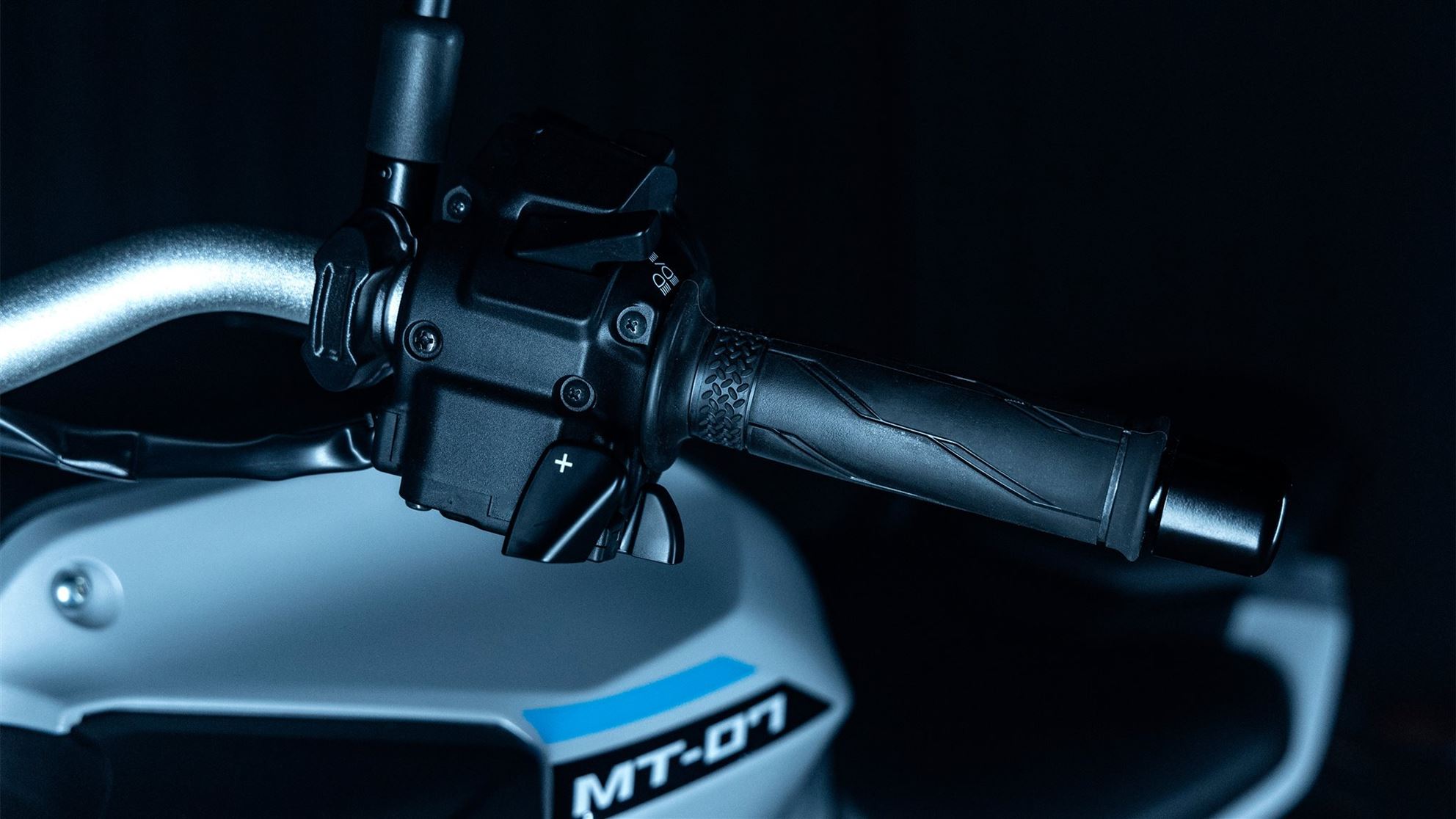
Die Schalteinheit für Y-AMT.
Erfahrung mit Y-AMT auf der Yamaha MT-07 2025
Ganz neu ist Y-AMT nicht, es ist bereits aus der großen Schwester MT-09 bekannt. Bisher gab es das Getriebe aber noch nicht für den CP2-Motor. Durch die Umstellung auf ein neues Ride-by-Wire-System für die MT-07 (und auch alle anderen Modelle, die einen CP2-Motor haben, beispielsweise Ténéré 700 oder Tracer 7) ist die Implementierung nun aber möglich. Die Schaltzeit beträgt laut Yamaha 0,1 Sekunden, in jeder Fahrsituation, sowohl hoch als auch runter.
Tatsächlich gehen die Gangwechsel im manuellen Modus (MT) zügig. Ein Knopfdruck über den See-Saw-Schalter (der eigentlich mehr eine Wippe ist) und zack, der Gang ist gewechselt. Trotzdem dauert es etwas, bis man sich daran gewöhnt hat, mit der linken Hand zu schalten und nicht mehr mit dem linken Fuß. Überraschend ist, dass das Runterschalten spürbar sanfter funktioniert als das Hochschalten. Bedient man das System in Schräglage, spürt man vor allem beim Hochschalten ein kurzes Rupfen. Es ist nicht störend, aber ein gut abgestimmter Quickshifter führt die Gangwechsel sanfter und weniger spürbar aus.
Beim Runterschalten ist Y-AMT auf Quickshifter-Niveau und es gibt keine Beanstandungen. Die Schaltgeschwindigkeit ist absolut ausreichend und konventionell nicht schneller zu machen. Etwas irritierend ist es jedoch, dass man beim Bergabfahren tendenziell früher einen Gang zurückschalten sollte, da man etwas Motorbremswirkung vermisst. Gerade bei einem Zweizylinder, dessen Motorbremswirkung eher höher ist, ein Umstand, der erst ins Fahrergehirn einprogrammiert werden will.
Wechselt man in den D bzw. D+-Modus, kümmert sich die MT-07 um alle Schalt- und Kupplungsvorgänge komplett automatisch. Hier fällt auf, dass trotz sportlicher Auslegung des D+-Modus beim Bergabfahren eher ein Gang zu hoch gewählt wird. Das führt dazu, dass – wenn man mit Stützgas durch die Kurven fahren möchte – deutlich mehr Gas geben muss, da die gewählte Drehzahl niedriger ist. Hier spürt man, dass das System eher konservativ und auf Spritsparen ausgelegt ist.
Praktisch: Auch im Automatikmodus kann der Fahrer über die Schaltwippe jederzeit das System überstimmen, also zusätzlich manuell runter- oder hochschalten. Nach einer gewissen Zeit (eher flott) übernimmt dann wieder Y-AMT die Schaltvorgänge. Wirklich praktisch ist Y-AMT im Stadtverkehr oder auf sehr engen Passstraßen, wenn man schon müde oder schlicht schaltfaul ist. Denn das System verhindert gekonnt ein Absterben des Motors, selbst wenn man noch so langsam und vorsichtig in eine Spitzkehre reinrollt.
Das kann gerade für Fahranfänger ein echtes Sicherheitsplus darstellen. Kauft man sich Y-AMT dazu, ist der Tempomat serienmäßig inkludiert. Für das konventionelle Schaltgetriebe ist der Tempomat auch nicht gegen Aufpreis erhältlich. Hier muss man sich also frühzeitig (direkt beim Kauf) entscheiden, wie wichtig einem dieses Feature ist. Nach dem Test in Spanien kann man uneingeschränkt sagen, dass Y-AMT absolut serienreif ist und sicher schnell seine Fans finden wird.
Perfekt ist das System noch nicht, vor allem wenn man eher sportlich unterwegs sein möchte. Interessante Randnotiz für Technikfans: Die Getriebe von Y-AMT und des 6-Gang-Schaltgetriebes sind nicht ident. Für Y-AMT wird eine andere Gangreihenfolge gewählt, nämlich N-1-2-3-4-5-6. Das ist für die Schaltlogik einfacher. Außerdem spart sich Y-AMT so eine Parkbremse. Man kann das Motorrad einfach im ersten Gang abstellen und starten.
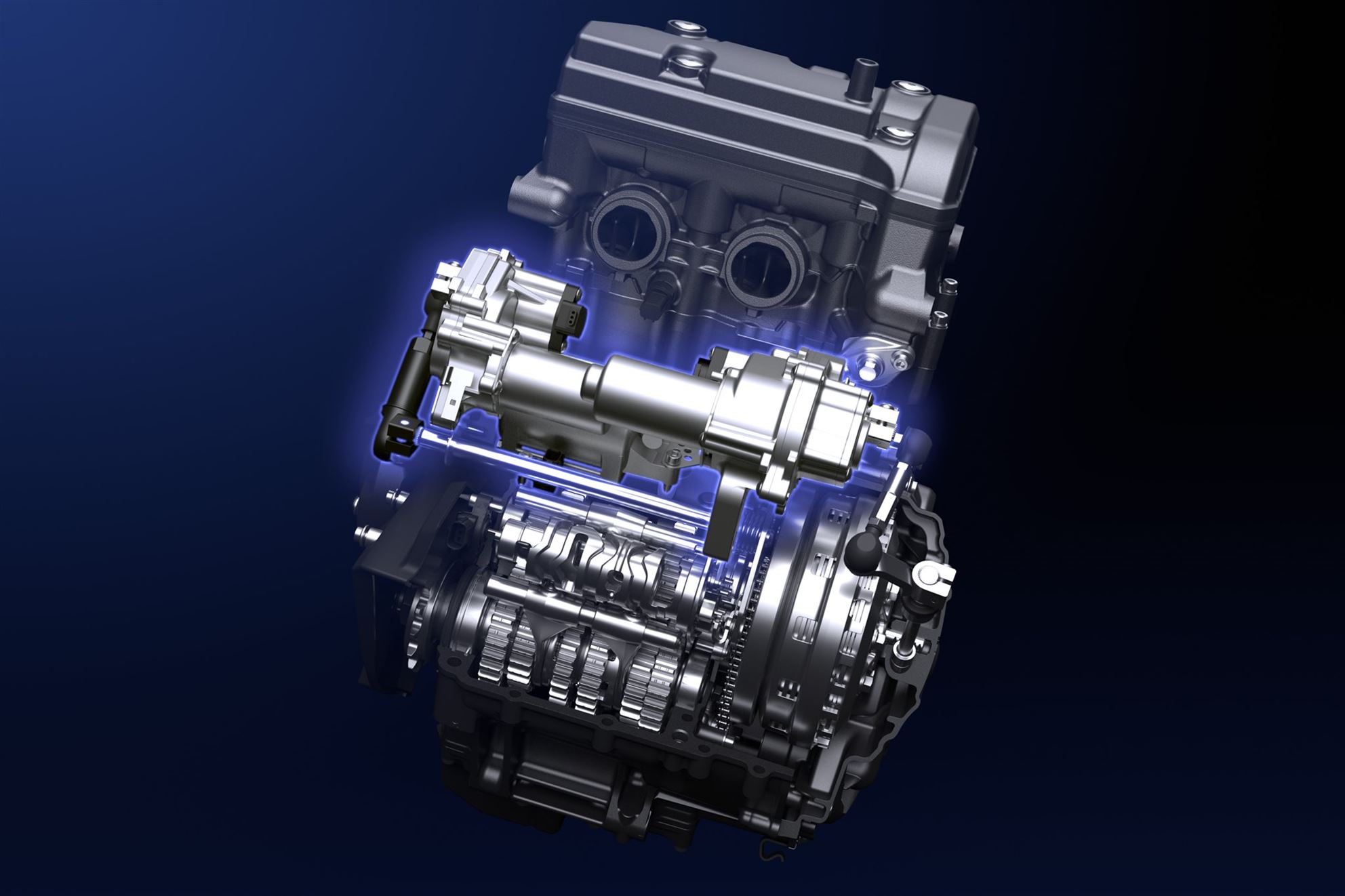
Die Y-AMT-Mechanik wiegt nur 2,8 kg.
Mehr Assistenzsysteme für die Yamaha MT-07 2025
Neben Fahrwerk, Getriebe und Design betrifft das große Modellupdate auch die Elektronik. Und das wird vermutlich sehr viele Interessenten freuen, denn bis dato war die MT-07 eher spartanisch ausgestattet, was die Fahrassistenzsysteme anging. Durch das bereits erwähnte Ride-by-Wire-System hat man jetzt drei verschiedene Ridingmodes zur Verfügung: Street, Sport und Custom. Diese unterscheiden sich in der Leistungsentfaltung und der Einstellung der Traktionskontrolle, die erstmals bei der MT-07 zum Einsatz kommt.
Wichtig zu wissen: Die Yamaha MT-07 in der vierten Generation hat keine 6-Achsen-IMU, was bedeutet, dass ABS und Traktionskontrolle nicht schräglagenabhängig agieren. Das bleibt der großen Schwester MT-09 vorbehalten. Bei unserem Test waren ABS und Traktionskontrolle aber absolut solide abgestimmt. Solange es nicht sehr wenig Grip gibt (glatter Asphalt, Nässe) wird die Traktionskontrolle aber nahezu nicht gebraucht, da die lineare Kraftentfaltung des CP2-Motors und die haftstarken Dunlop-Pneus die Kraft in fast jeder Fahrsituation ausreichend auf die Straße bringen, ganz ohne Schlupf.
Die Traktionskontrolle ist trotzdem komplett deaktivierbar, dafür muss man nur in einem Untermenü auf dem 5-Zoll-Farb-TFT-Display die TC deaktivieren. Dreht man dann die Zündung ab und wieder an, muss man das Spiel wiederholen, weil die Traktionskontrolle dann automatisch wieder aktiviert ist. Eine bewusste Entscheidung von Yamaha pro Sicherheit für den Fahrer. Wer gerne am Hinterrad fährt, muss die TC deaktivieren und sollte zum konventionellen Getriebe greifen. Dann klappt es im Handumdrehen mit dem Hinterradfahren – dem hohen Drehmoment der MT-07 sei Dank.

Das neue 5-Zoll-TFT-Display ist gut gelungen - und sehr informativ.
Design ähnelt der Yamaha MT-09
Die neue Lichtmaske mit LED-Leuchtmitteln lehnt sich stark an jene der großen Schwester MT-09 an. Ebenso die Bedienelemente, das Display und das Finish des gesamten Bikes. Optisch bleibt die MT-07 ihrer Grundlinie treu, aber durch die USD-Gabel, die Radialbremszangen und die neue Lichtmaske muss man schon zweimal hinschauen, um zu erkennen, dass es eine MT-07 und keine MT-09 ist – vor allem von vorne.
Drei Farben stehen zur Auswahl: Ice Storm (ein mattes Grau mit hellblauen Felgen), Icon Blue (Yamaha-Blau mit mattblauer Maske und Fender und blauen Felgen)) und Tech Black. Es gibt eine reichhaltiges Originalzubehörprogramm, das 96 Teile umfasst, davon 32 neue Teile für die vierte Generation der MT-07 - Akrapovic-Anlage inklusive.
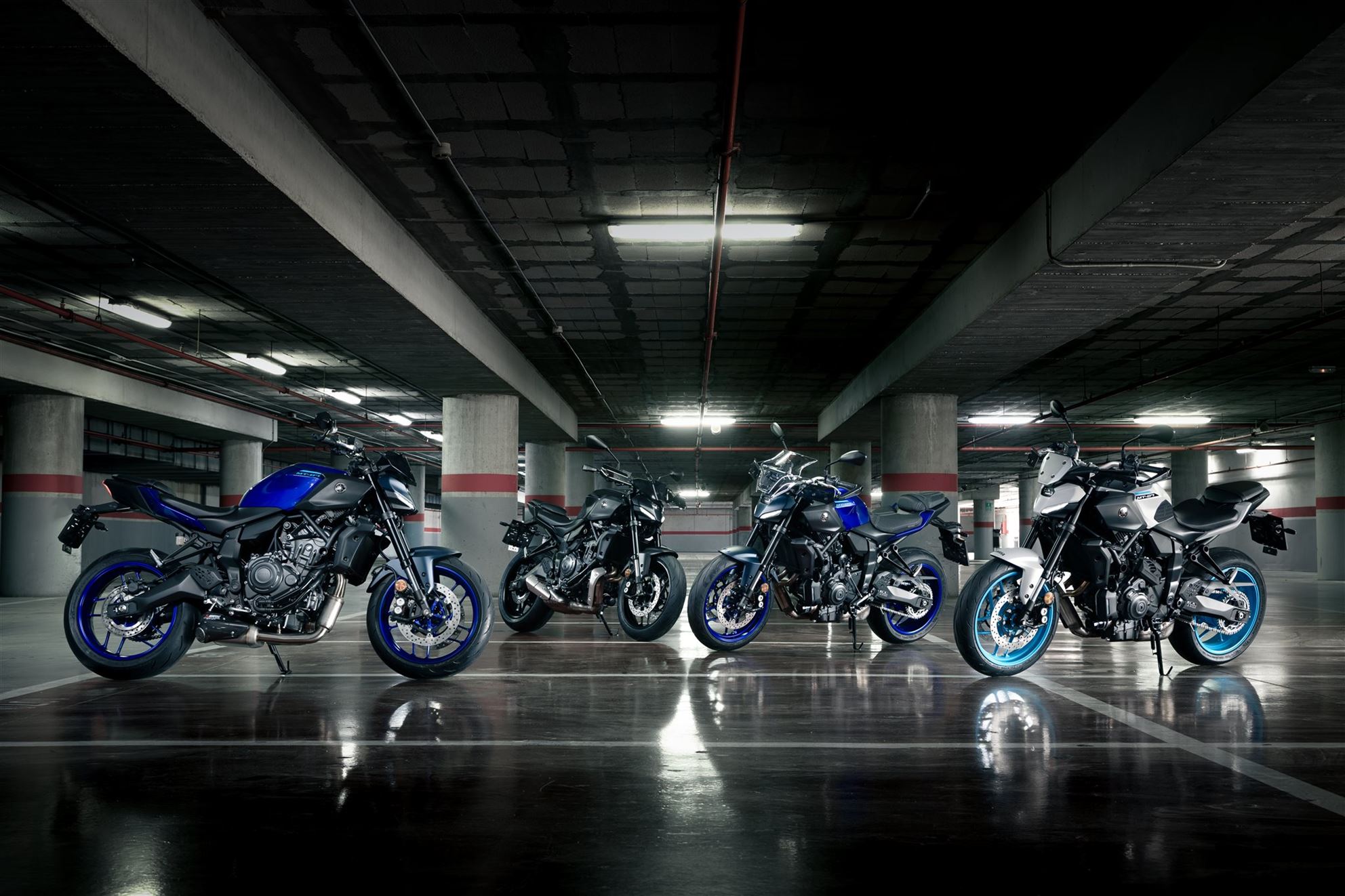
Durch ein reichhaltiges Zubehörprogramm lässt sich die MT-07 leicht individualisieren.
Preise Yamaha MT-07 / Y-AMT 2025
In Deutschland kostet die Yamaha MT-07 ab 8.524 Euro, Y-AMT kostet 500 Euro Aufpreis. In Österreich startet die MT-07 bei 8.799 Euro, Y-AMT kostet 600 Euro Aufpreis. In der Schweiz fängt die MT-07 bei 8.590 CHF an, mit Y-AMT kostet sie 8.990 CHF (400 CHF Aufpreis). Verfügbar sind die Modelle bereits ab jetzt beim Yamaha-Händler.
Erfahrungen mit Motorradbekleidung von Vanucci und MTR Helm
Da die Yamaha MT-07 tendenziell jüngere Fahrer und Einsteiger abholen soll, wollten wir auch bewusst preiswerte Motorradbekleidung für genau jene Zielgruppe beim MT-07-Test ausprobieren.
Der Helm kommt von der Louis-Eigenmarke MTR und heißt S-1 Fiber in Mattschwarz. Der Helm erfüllt die letzte Prüfnorm ECE 22.06 und ist mir rund 1,45 Kilogramm eher ein leichtere Helm. Er besitzt eine integrierte Sonnenblende, das klare Visier ab Werk ist vorbereitet für eine Pinlock-Anti-Beschlag-Innenscheibe. Wir haben das optional getönte Hauptvisier noch dazu geordert. Der Helm zeichnet sich durch seinen niedrigen Preis aus, aktuell 149,99 Euro und seinen sehr komfortablen Sitz. Das Innenfutter ist weich und sehr anpassungsfähig. Grundsätzlich ist der Helm von der Kopfgröße her genau richtig geschnitten, die Außenschale des Helms ist aber eher kompakt.
Das merkt man, da man zwischen Lippen und Kinnbereich nicht mehr viel Platz hat. Zwei Belüftungen sind vorhanden (Stirn und Kinn), diese lassen sich auch mit Motorradhandschuhen leicht bedienen. Die Stirnbelüftung hat spürbar gekühlt, die Kinnbelüftung war eher unauffällig. Der Ratschenverschluss ist angenehm dick gepolstert, was den sehr hohen Tragekomfort unterstreicht. Ein Helm, der wirklich ein sehr attraktives Preis-Leistungsverhältnis bietet.
Die Jacke ist von Vanucci, Modell RVX-3. Eine Textiljacke mit einem leicht sportlichen Schnitt, wasserabweisend und angenehm winddicht. Ein warmes Innenfutter kann herausgenommen werden und die Softprotektoren an Schultern und Ellbogen sitzen gut. Eine mehrstündige Regenfahrt im Stadtverkehr hat die Jacke trocken gemeistert. Lediglich beim Ärmelende kann etwas Feuchtigkeit reingedrückt werden. Praktisch: die Belüftungsöffnungen auf den Oberarmen für hohe Temperaturen im Sommer. Mit dem Innenfutter ist die Jacke für die ganze Saison geeignet. Wir haben noch einen dickeren Rückenprotektor nachgerüstet. Für knapp 250 Euro lässt die Jacke kaum Wünsche offen.
Die Motorradjeans VUT-7, ebenfalls von Vanucci, ist aktuell in Aktion für 219,97 Euro und ist vor allem angenehm und motorradtauglich geschnitten. Die soften Hüftprotektoren sind groß aber nicht störend dimensioniert. Die Soft-Knieprotektoren sind etwas fummelig mittels zwei Klettverschlüssen zu fixieren, dafür aber auch noch in der Höhe einstellbar. Der Schnitt ist etwas weiter als bei normalen Jeans dieser Größe, vor allem fällt die Hose etwas länger aus. Das ist aber für Motorradfahrer sinnvoll, da man durch den Kniewinkel beim Sitzen sonst schnell mal freie Knöchel hätte. Während der ersten Regenfahrt hat die Hose nur ganz minimal abgefärbt, für Jeans aber nicht unüblich. Die Verarbeitung und die Materialdicke sind tadellos.
Besonders gut haben die Vanucci Motorradschuhe VUB-5 gefallen. Dank SympaTex sind die sportlich aussehenden Motorradsneakers wirklich angenehm regenfest und halten die Füße zuverlässig trocken. Dafür gibt es sonst keine echte Belüftung und man neigt zu leichten Schweißfüßen darin. Der Schnitt ist normal, nicht zu eng, nicht zu weit und die Größe fällt ungefähr ähnlich zu Sportschuhen aus.
Einziger Knackpunkt bei den Schuhen: Man hat sowohl einen Schnürverschluss als auch einen seitlichen Reißverschluss. Normalerweise sind die Reißverschlüsse dafür gedacht, dass man den Schuh nicht jedes Mal auf- und zuschnüren muss. Bindet man ihn aber enger, reicht die Länge des Reißverschlusses nicht aus, um den Motorradschuh ohne Schnürung an- und auszuziehen. Die Sohle ist grippig, selbst bei Nässe.
Die leichten Handschuhe Vanucci VCT-1 sind eher unauffällige Begleiter im Motorradalltag. Der Knöchelschutz ist angenehm geformt, ebenso die Finger. Eine leichte Verstärkung am Handballen stört auch nicht beim Fahren. Tendenziell sind diese Handschuhe eher für warme Temperaturen für knapp 20 Grad und mehr zu empfehlen, da sie nicht besonders winddicht sind. Das gesamte Outfit liegt bei unter 850 Euro und ist definitiv zu empfehlen. Da gibt es für mehr Geld deutlich unbequemere Motorradbekleidung.
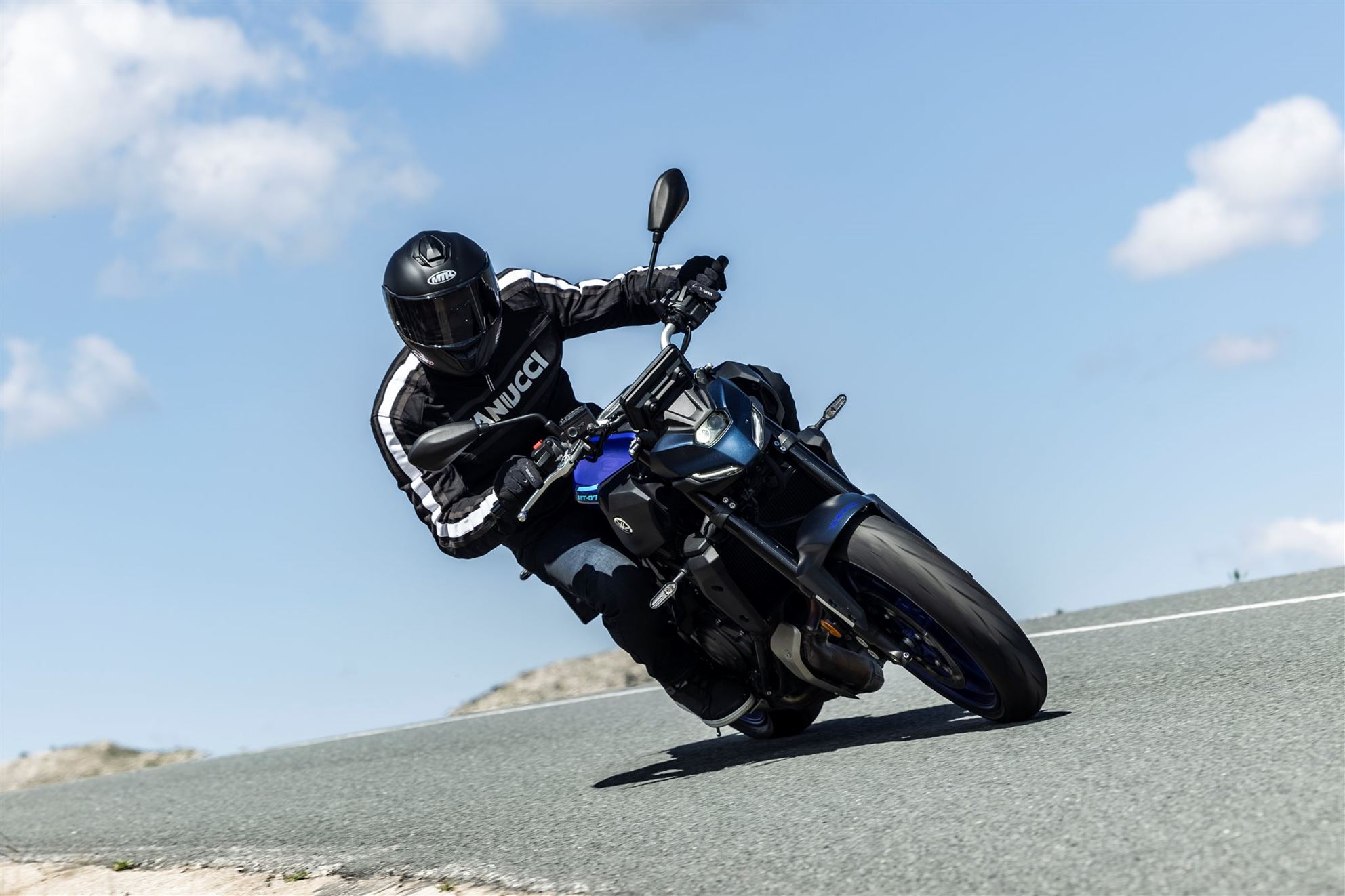
Cooles Outfit, um unter 850 Euro! Wo? Bei Louis.
- How much does a Yamaha MT-07 cost?
- Here you will find an overview of the price level of new and used motorbikes!
&width=60&height=60&bgcolor=rgba_39_42_44_0&mode=crop)
Yamaha MT-07 2025 - Experiences and Expert Review
Philipp
Die neue Yamaha MT-07 ist die Beste, die es je gab. Die Kritikpunkte und die Wünsche der MT-07-Fahrer wurden gehört und umgesetzt. Die neue MT-07 fährt in jedem Belang besser, stabiler und macht die Spreizung noch größer: Sowohl Anfänger und Einsteiger werden mit ihr zurechtkommen, als auch bereit sehr routinierte Piloten, da sie nun ein reiferes, potenteres Motorrad ist. Die Lücke zur Konkurrenz hat sie geschlossen, nur bei der reinen Motorleistung hat man noch 10-20 PS Rückstand auf die Konkurrenz. Das ist aber nicht weiter schlimm, da der CP2-Motor trotzdem ein Garant für Fahrspaß und ein breites Grinsen unterm Helm ist. Ob man das optionale Y-AMT-Getriebe wählen sollte oder nicht, sollte man unbedingt selbst im Rahmen einer Probefahrt ausprobieren - der Aufpreis dafür ist human. Daher: Großes Lob an die Yamaha-Ingenieure, die ihren Megaseller deutlich aufgewertet haben, ohne den Charakter der MT-07 zu verändert. Ein Problem hat Yamaha jetzt aber doch: Die Restwerte der bisherigen drei Generationen werden wohl purzeln, denn die Unterschiede zur aktuellen Generation sind spürbar groß. Und bekanntlich ist das Bessere der Feind des Guten.
More from 1000PS Magazine
Test Yamaha MT-07 2025 Images
Source: 1000PS












































































































